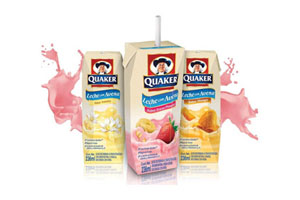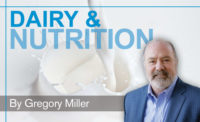
|
| Leche con Avena is a milk-based beverage with 4% whole-grain oats from PepsiCo for the Mexican market. |
Start with something healthy, and then make it better. That’s the basic recipe for creating a value-added milk-based beverage. Traditionally, the three largest and most active claims about dairy beverages regarded digestive/gut health, heart/cardiovascular health and bone health. But, in recent years, the market has seen many novel dairy beverages that tout energy, immune health, weight control, satiety, anti-aging, skin health, beauty, eye health, joint health, mental acuity and concentration.
According to the InnovaDatabase report “Top Trends in Functional Dairy Products,” 14,000 dairy products were launched globally in the 12 months ended May 2011. Dairy drinks accounted for 24% of total launches. Most carried some type of health claim, either passive or active. Examples of passive claims are sugar-free, low-calorie or natural. Examples of active claims are added-calcium, double the protein or plus omega-3/DHA. A newer trend is to claim multiple benefits, starting with a passive benefit and adding one or more specialty ingredients that enable the beverage manufacturer to claim active benefits.
Ingredient options from A to (fiz)Z
The Innova report listed the most popular ingredients used to fortify milk-based beverages as probiotics/prebiotics, plant sterols and calcium. Yet there are many other value-added ingredient options for dairy. Let’s explore a few.
- Antioxidants. Chocolate and milk go together like a horse and carriage. A study by the Agricultural Research Service found that chocolate and cocoa powders are derived from beans that contain hefty quantities of flavonoids, which are natural antioxidants. Natural (nonalkalized) cocoa powder contains the highest levels of these flavanol antioxidants.
- Bioactive Peptides. Bioactive peptides and potassium have been used in products both in Europe and the United States, supporting heart health.
- Fiber and Prebiotics. Fiber — especially soluble fiber — has been used effectively in dairy as a prebiotic.
- Natural Dairy Minerals. Calcium and other dairy minerals have traditionally been promoted for bone health, but potassium is also an important mineral for heart health and sports recovery. At this year’s Annual IFT Meeting and Food Expo, the U.S. Dairy Export Council displayed a “Dairy Mineral Thirst-quencher” (see http://tinyurl.com/9j33m5s), featuring dairy permeate as a source of calcium and potassium naturally found in dairy.
- Oats. PepsiCo debuted a “Leche con Avena*” in the Mexican market under its Quaker brand. This milk-based beverage contains 4% whole-grain oats and features mango, strawberry/banana and vanilla flavors.
- Omega-3s and Plant Sterols. Research shows strong evidence that the omega-3s EPA and DHA not only promote heart heath but also may have multiple other benefits. Plant sterols have cholesterol-lowering properties.
- Probiotics. Some estimates put the global probiotic drinks market alone at more than $10 billion a year. Asians are particularly fond of the one-a-day shot-style dose delivery products. Danone’s multinational probiotic brand Actimel dominates the market.
- Protein. Although dairy contains protein naturally, additional amounts can be added to dairy-based beverages. The Dairy Research Institute has recently conducted research on micellar casein and heat-stable whey proteins for beverage applications.
- Sweeteners.The Dairy Research Institute is also completing research on hydrolyzing lactose to reduce the total levels of sugar in milk-based beverages. More information will be available soon.
- Vitamin D. Beverages for bone health may want to use extra vitamin D and other ingredients to help boost calcium absorption and bone formation.
- Yogurt.Yogurt, especially Greek-style, is very trendy. Higher protein levels within yogurt create another natural, healthy halo for dairy snacks and beverages.
- Fizz. Don’t forget that fun and unique textures can create value. Who knows? Carbonation just might propel your next dairy innovation into the winners’ circle.



